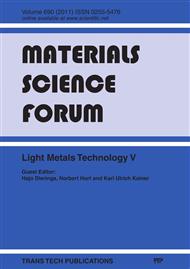p.422
p.429
p.433
p.439
p.443
p.447
p.451
p.455
p.459
Challenges and Solutions in Distortion Engineering of an Aluminium Die Casting Component
Abstract:
The demand for increased efficiency of resources in industrial manufacturing processes requires continuous developments of materials and production processes. Aluminium components especially used in automotive applications meet the requirements of weight optimised and energy efficient solutions. In this context vacuum die casting enables the production of complex weight optimised components. However, in view of ensuring the needed dimensional accuracy, the productivity potential of the process is still restricted. Hence, the distortion behaviour within the whole process chain of a die casting structural part made of alloy AlSi10Mg was systematically investigated. Starting with the initial state after casting the analysis was focused on the quenching, punching, precipitation hardening and machining of the components. Contour deviations were recorded via a photogrammetry system and a coordinate measuring machine. Especially after die casting and solution annealing significant contour deviations were observed. Residual stress measurements along the process chain pointed out that residual stresses from die casting were released by solution annealing. By the knowledge of distortion sensitive component areas and the understanding of distortion mechanisms compensation strategies were derived based on the investigated processes. Within the paper these deduced strategies and the way to reduce expensive straightening processes and to raise efficiency will be given for industrial applications.
Info:
Periodical:
Pages:
443-446
Citation:
Online since:
June 2011
Authors:
Price:
Сopyright:
© 2011 Trans Tech Publications Ltd. All Rights Reserved
Share:
Citation:


